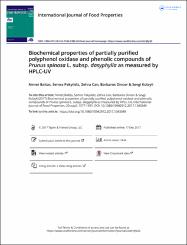Biochemical properties of partially purified polyphenol oxidase and phenolic compounds of Prunus spinosa L. subsp dasyphylla as measured by HPLC-UV
Künye
Baltaş, N., Pakyıldız, S., Can, Z., Dinçer, B. & Kolaylı, S. (2017). Biochemical properties of partially purified polyphenol oxidase and phenolic compounds of Prunus spinosa L. subsp dasyphylla as measured by HPLC-UV. International Journal of Food Properties, 20, 1377-1391. https://doi.org/10.1080/10942912.2017.1343349Özet
Polyphenol oxidase (PPO) enzyme was extracted from Prunus spinosa L. subsp. dasyphylla plum, partially purified by acetone precipitation, and its biochemical properties were investigated. Different substrates (p-coumaric acid, L-tyrosine, p-hydroxyphenyl propionic acid (PHPPA), catechol, 4-methylcatechol (4-MTC), hydrocaffeic acid, gallic acid, quercetin, catechin, and epicatechin) were analysed to determine their affinities with Prunus spinosa PPO (PsPPO). the substrate specificity was in the following order: 4-MTC > catechol > hydrocaffeic acid > catechin > epicatechin. 4-MTC was the most suitable substrate (K-m = 0.97 mM and V-max = 4753 U/mg protein). the optimal pH values were 7.0 for 4-MTC and catechol, 5.0 for catechin and epicatechin, and 4.0-6.0 for hydrocaffeic acid. Optimal temperatures were 40 degrees C for 4-MTC, 30 degrees C for catechol, and 60 degrees C for catechin, epicatechin, and hydrocaffeic acid. in the inhibition tests, the most potent inhibitor was found to be sodium metabisulphite (IC50 = 0.01 mM), followed by ascorbic acid, thiourea, benzoic acid, L-cysteine, and sodium azide. Approximately 80 and 75% of the diphenolase activity was conserved at pH 5.0 and 7.0, respectively, at 4 degrees C after 7 d incubation. Moreover, native polyacrylamide gel electrophoresis (Native-PAGE) of the enriched extract revealed the presence of at least six bands with PPO activity, suggesting the existence of different PPO isoforms. However, the oxidation of diphenol related to browning significantly, so the data obtained in this research provided a basis for the prevention of enzymatic browning of Prunus spinosa during processing. High-performance liquid chromatography (HPLC) revealed the plum extract contained protocatechuic acid, p-OH benzoic acid, vanillic acid, syringic acid, epicatechin, p-coumaric acid, and luteolin.


















